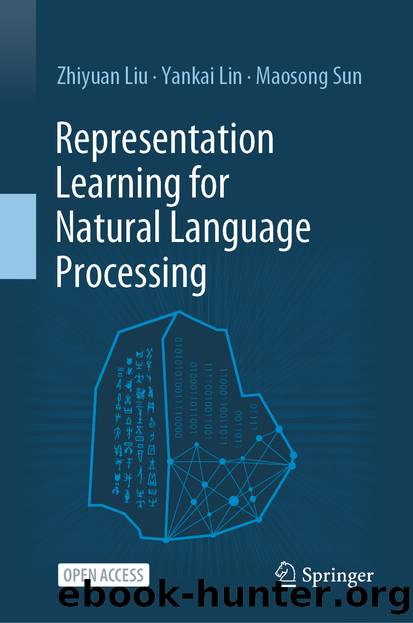Representation Learning for Natural Language Processing by Zhiyuan Liu & Yankai Lin & Maosong Sun

Author:Zhiyuan Liu & Yankai Lin & Maosong Sun
Language: eng
Format: epub
ISBN: 9789811555732
Publisher: Springer Singapore
7.1.1 World Knowledge Graphs
In ancient times, knowledge was stored and inherited through books and letters written on parchment or bamboo slip. With the Internet thriving in the twenty-first century, millions of thousands of messages have flooded into the World Wide Web, and knowledge was transferred to the semi-structured textual information on the web. However, due to the information explosion, it is not easy to extract knowledge we want from the significant, noisy plain text on the Internet. To obtain knowledge effectively, people notice that the world is not only made of strings but also made of entities and relations. Knowledge Graph, which arranges structured multi-relational data of concrete entities and abstract concepts in the real world, is blooming in recent years and attracts wide attention in both academia and industry.
KGs are usually constructed from existing Semantic Web datasets in Resource Description Framework (RDF) with the help of manual annotation, while it can also be automatically enriched by extracting knowledge from large plain texts on the Internet. A typical KG usually contains two elements, including entities (i.e., concrete entities and abstract concepts in the real world) and relations between entities. It usually represents knowledge with large quantities of triple facts in the triple form of head entity, relation, tail entity abridged as . For example, William Shakespeare is a famous English poet and playwright, who is widely regarded as the greatest writer in the English language, and Romeo and Juliet is one of his masterpieces. In knowledge graph, we will represent this knowledge as William Shakespeare, works_written, Romeo and Juliet. Note that in the real world, the same head entity and relation may have multiple tail entities (e.g., William Shakespeare also wrote Hamlet and A Midsummer Night’s Dream), and reversely the same situation will happen when tail entity and relation are fixed. Even it is possible when both the head entity and tail entity are multiple (e.g., in relations like actor_in_movie). However, in KG, all knowledge can be represented in triple facts regardless of the types of entities and relations. Through these triples, we can generate a huge directed graph whose nodes correspond to entities and edges correspond to relations to model the real world. With the well-structured united knowledge representation, KGs are widely used in a variety of applications to enhance their system performance.
There are several KGs widely utilized nowadays in applications of information retrieval and question answering. In this subsection, we will introduce some famous KGs such as Freebase, DBpedia, Yago, and WordNet. In fact, there are also lots of comparatively smaller KGs in specific fields of knowledge functioned in vertical search.
Download
This site does not store any files on its server. We only index and link to content provided by other sites. Please contact the content providers to delete copyright contents if any and email us, we'll remove relevant links or contents immediately.
Algorithms of the Intelligent Web by Haralambos Marmanis;Dmitry Babenko(8300)
Test-Driven Development with Java by Alan Mellor(6721)
Data Augmentation with Python by Duc Haba(6636)
Principles of Data Fabric by Sonia Mezzetta(6386)
Learn Blender Simulations the Right Way by Stephen Pearson(6284)
Microservices with Spring Boot 3 and Spring Cloud by Magnus Larsson(6156)
Hadoop in Practice by Alex Holmes(5958)
Jquery UI in Action : Master the concepts Of Jquery UI: A Step By Step Approach by ANMOL GOYAL(5806)
RPA Solution Architect's Handbook by Sachin Sahgal(5552)
Big Data Analysis with Python by Ivan Marin(5363)
The Infinite Retina by Robert Scoble Irena Cronin(5246)
Life 3.0: Being Human in the Age of Artificial Intelligence by Tegmark Max(5147)
Pretrain Vision and Large Language Models in Python by Emily Webber(4327)
Infrastructure as Code for Beginners by Russ McKendrick(4086)
Functional Programming in JavaScript by Mantyla Dan(4038)
The Age of Surveillance Capitalism by Shoshana Zuboff(3950)
WordPress Plugin Development Cookbook by Yannick Lefebvre(3801)
Embracing Microservices Design by Ovais Mehboob Ahmed Khan Nabil Siddiqui and Timothy Oleson(3605)
Applied Machine Learning for Healthcare and Life Sciences Using AWS by Ujjwal Ratan(3577)
